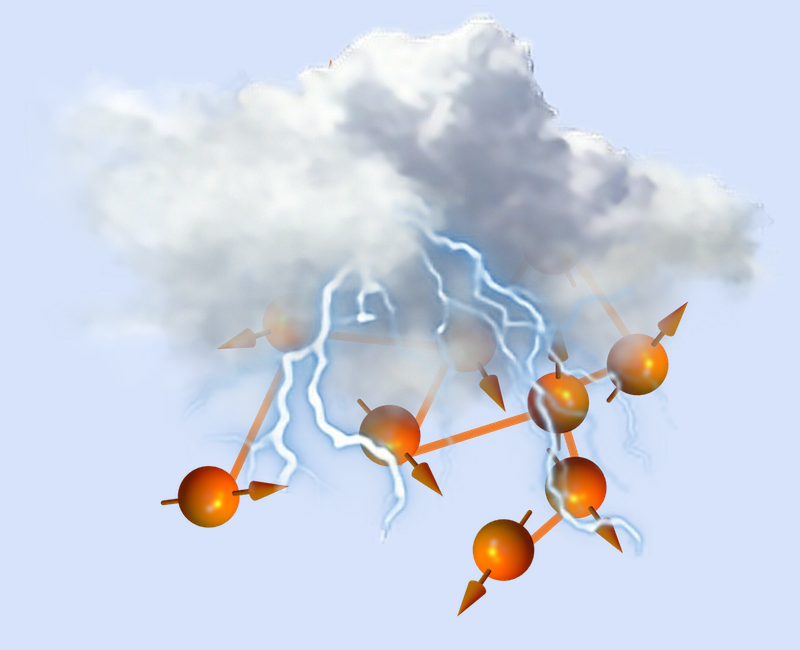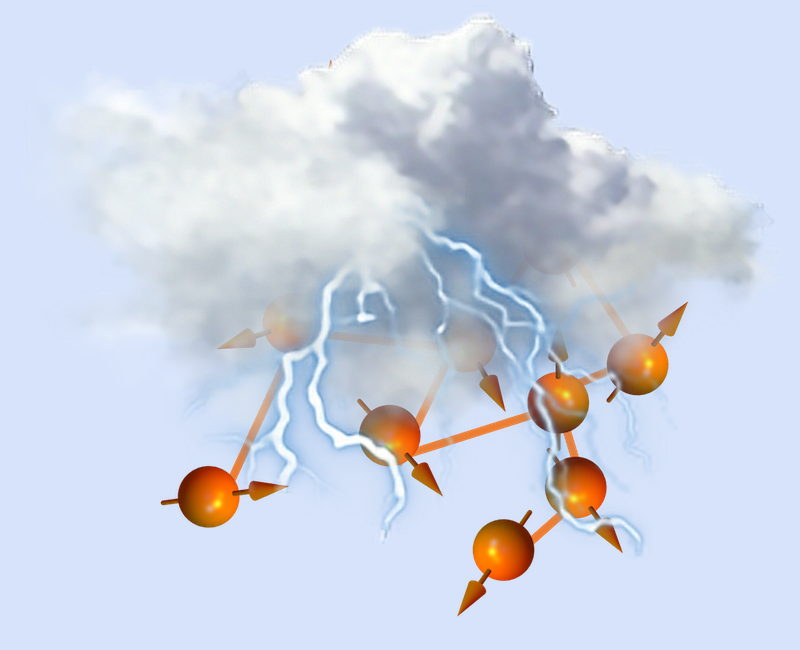Sorting Out Quantum Chaos
The quest for understanding quantum systems of many particles—and the exotic phenomena they display—fascinates theorists and experimentalists alike, but it’s one with many hurdles. The number of the system’s quantum states increases exponentially with size; these states are hard to prepare, probe, and characterize in experiments, and interactions with the environment “open” the system, further increasing the number of states to consider. As a result, open, many-body quantum systems remain a frontier of exploration in physics, for which researchers haven’t developed a systematic theoretical framework. A new study by Kohei Kawabata of Princeton University and colleagues has taken an important step toward developing such a general framework by offering a complete classification of these systems based on symmetry principles [1] (Fig. 1). The classification will help researchers chart the territory of possible phenomena that might emerge in a vast range of open, many-body systems, including those that might display “quantum chaos.”
The researchers’ achievement builds on seminal breakthroughs obtained over many decades. In the early 1950s, Hungarian physicist Eugene Wigner introduced random matrix theory to describe the energy spectra of heavy nuclei such as uranium [2, 3]. Wigner showed that the Hamiltonians describing those systems—the operators determining the system’s quantum states and dynamics—could be modeled using matrices whose elements are random variables. The distribution of nuclei’s spectral lines could then be related to that of matrix eigenvalues. Ensuing work by Freeman Dyson classified such random matrices into different classes according to mathematical symmetries [4]. Such symmetries can be used to place constraints on the matrices, a simplification that boosts the power for tackling otherwise intractable systems.
Random matrices have grown into an exciting area of research with applications in physics and other fields—including finance and neuroscience [5]. They also hold promise for tackling important problems related to quantum chaos [6]. Quantum chaos investigates how classical chaos—the exponential sensitivity of a system to its initial conditions, often referred to as the butterfly effect—can emerge from quantum principles. In the 1970s, the so-called Bohigas–Giannoni–Schmit conjecture brought together random matrix theory and Hamiltonian-based descriptions. The conjecture states that a Hamiltonian quantum system exhibiting chaos in the classical limit must have a random matrix theory representation.
However, a quantum system can only be described by a Hamiltonian under idealized conditions whereby the interactions with the environment are negligible. In reality, an open system gets entangled with the environment, which leads to decoherence and decay of coherent quantum superpositions. The description of these systems was greatly advanced in the 1970s. In particular, in 1976 physicist Göran Lindblad identified a universal equation, known today as a Lindblad master equation, which governs the evolution of an open quantum system that’s “forgetful,” or Markovian—its evolution from a given state is independent of its prior history [7]. In this equation, the role of the Hamiltonian is played by a more complex mathematical object, a “superoperator” called the Lindbladian. This superoperator has a universal structure that accounts for the system’s Hamiltonian and for the coupling with the surrounding environment. More recent research combined the insights of Wigner, Dyson, and Lindblad, bringing together random matrices and Lindbladians to construct “random Lindbladians.”
The contribution of Kawabata’s team lies in providing a symmetry-based classification for arbitrary Lindbladians. In his early work, Wigner classified random matrices based on a restricted class of symmetries. In 1997, Alexander Altland and Martin Zirnbauer classified Hamiltonians based on a larger set of symmetries—including time-reversal, particle-hole, and chiral symmetries [8]. Their identification of ten symmetry classes had a profound impact on physics, with applications from Anderson localization to topological insulators.
Can a similarly powerful classification be extended from Hamiltonians to Lindbladians? A previous result obtained by a team also led by Kawabata provided a necessary ingredient for this extension. Lindbladians can be mapped onto Hamiltonians by employing an alternative representation that introduces auxiliary degrees of freedom of the described quantum system. In such representation, the system’s dynamics are governed by a non-Hermitian Hamiltonian. Conventional Hamiltonians are represented by a Hermitian matrix, whose real eigenvalues correspond to the system’s energy levels. This non-Hermitian matrix instead has complex eigenvalues, whose real parts characterize energy levels and whose imaginary parts determine the lifetimes of the corresponding states. In 2019, Kawabata and colleagues generalized the Altland-Zirnbauer classification to non-Hermitian matrices, classifying them in 38, rather than ten, symmetry classes [9]. Yet, non-Hermitian matrices describing Lindbladians are subject to additional constraints imposed by the universal form reflecting the interaction of the system with the environment. Notwithstanding this problem, in the new work the researchers were able to account for such constraints and thereby generalize the classification of non-Hermitian systems to arbitrary Lindbladians.
To test their classification framework and showcase its potential for discovery, the researchers analyze two well-studied systems, one with bosonic statistics (a quantum spin model in a dissipative setting) and one with fermionic statistics (a Markovian version of the Sachdev-Ye-Kitaev model involving Majorana fermions, a paradigm for quantum chaos). For both cases, they derived “periodic tables” that identify the symmetry classes of these families of systems. The new framework not only allowed the team to recover previous results obtained for these systems, but also to pinpoint some promising directions where, depending on system parameters, some new, exotic behavior might be spotted.
The classification developed by Kawabata and colleagues is likely to have a profound and long-lasting impact, fostering the understanding of quantum chaos in open systems and helping to identify and discover salient phenomena that these systems might exhibit. Fruitful extensions of this work can be envisioned by moving away from the Markovian limit to the much more general setting of non-Markovian systems, with no assumptions on the memory of the environment. What’s more, symmetry-based classification schemes, in combination with random matrix theory, may be carried over to quantum information theory, with applications to the description of arbitrary physical operations on quantum states, known as quantum channels, as well as of superchannels, which are maps between such operations.
References
- K. Kawabata et al., “Symmetry of open quantum systems: Classification of dissipative quantum chaos,” PRX Quantum 4, 030328 (2023).
- E. P. Wigner, “On the statistical distribution of the widths and spacings of nuclear resonance levels,” Math. Proc. Camb. Phil. Soc. 47, 790 (1951).
- E. P. Wigner, “On the distribution of the roots of certain symmetric matrices,” Ann. Math. 67, 325 (1958).
- F. J. Dyson, “The threefold way. Algebraic structure of symmetry groups and ensembles in quantum mechanics,” J. Math. Phys. 3, 1199 (1962).
- P. J. Forrester, Log-Gases and Random Matrices, London Mathematical Society Monographs Vol. 34 (Princeton University Press, New Jersey, 2010)[Amazon][WorldCat].
- F. Haake et al., Quantum Signatures of Chaos, Springer Series in Synergetics (Springer, Cham, 2018)[Amazon][WorldCat].
- G. Lindblad, “On the generators of quantum dynamical semigroups,” Commun. Math. Phys. 48, 119 (1976).
- A. Altland and M. R. Zirnbauer, “Nonstandard symmetry classes in mesoscopic normal-superconducting hybrid structures,” Phys. Rev. B 55, 1142 (1997).
- K. Kawabata et al., “Symmetry and topology in non-Hermitian physics,” Phys. Rev. X 9, 041015 (2019).





